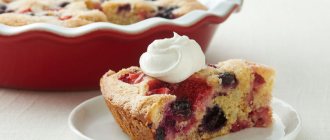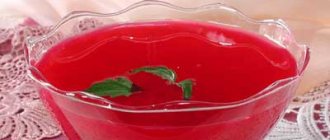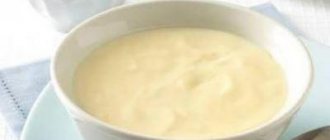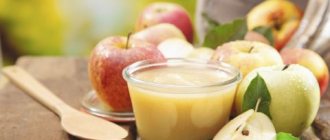Since milk is the baby’s main source of nutrition, his mother is obliged to monitor her diet and not eat anything that can harm the baby.
But among the exact “dos” and “nots,” there are foods that doctors are still arguing about, such as semolina during breastfeeding.
Some experts argue that if the product gets into the baby’s body with mother’s milk, the product will harm him, others argue that there will only be benefits: what is the truth remains to be seen.
The whole truth about semolina and its effect on babies
Some doctors openly scare new mothers with the consequences of eating semolina, but what are such warnings based on and can dietary semolina really harm the baby’s unprotected body. Let's figure it out. To begin with, let’s highlight those points because of which pediatricians do not recommend feeding your baby semolina through milk.
- The porridge contains phytin, which “binds” calcium in the child’s gastrointestinal tract, preventing the mineral from participating in the proper construction of bones and the development of vital systems of the growing body. Accordingly, if there is not enough calcium in the baby’s body, “rickets” may develop, the first sign of which is crooked legs.
- Doctors also worry about celiac enteropathy – gluten intolerance. Considering that semolina contains a high content of vegetable gluten protein, this can cause an allergy in the baby or worsen its digestion process.
- Cereals lack sufficient amounts of vitamins and minerals.
- The high calorie content of the product leads to intestinal colic, bloating and increased gas formation in the baby.
These are the reasons why many doctors do not recommend consuming semolina, but is it really so scary and dangerous? Where is the truth and where is the myth – we will now analyze in detail.
What is semolina porridge
Semolina is coarsely ground wheat. Small crushed grains are used for the production of pasta, and large ones are groats, the inner shell of wheat.
Fitin leads to rickets: fact or fiction
Let us remember that phytin is an organic compound that is found in the outer shell of cereals; it is also found in vegetables, meat, fish, and legumes. Note: phytin lives on the outside of the grain, and semolina lives on the inside of the wheat. Accordingly, there is practically no phytin in it. But bran and whole grain cereals are rich in this substance. It makes more sense, in this case, not to eat bread and oatmeal.
Recent studies have shown that removing phytin from the diet has no effect on blood calcium levels. By the way, the substance is neutralized by yeast. Phytin can cause harm to children already suffering from anemia and rickets, but in no way can cause their occurrence.
Having looked at the label on the cereal package, we see that there is 4 times less calcium in semolina than phosphorus. This means that in order for the mineral to be absorbed, the porridge must be cooked in calcium-rich milk. There will be practically no it in semolina on water.
First conclusion:
Semolina will not harm a healthy child, provided the mother follows the norm for its consumption. The minimum amount of phytin in semolina porridge is not a reason to refuse it. Semolina does not lead to rickets.
Celiac enteropathy: facts pros and cons
Some people from birth do not have enzymes capable of breaking down plant protein, that is, gluten. Other children may temporarily stop digesting gluten after a “blow” to beneficial microorganisms in the gastrointestinal tract. Since you cannot determine this by eye, you need to use a product new to your child with caution. And this applies not only to semolina.
Some cereals contain a lot of gluten, which causes allergies or impairs the digestion process. Therefore, semolina porridge should be gradually introduced into the diet of a nursing mother, because it is especially rich in gluten. Observe the child's reaction. For the first time, just try 100 grams of cereal cooked in water.
The microflora, as well as the intestinal walls of the baby, are just forming, so the mother needs to be careful when consuming foods new to the baby. A baby's gastrointestinal tract is formed before one year, so the baby needs gentle nutrition.
Signs of gluten intolerance in newborns
Why is gluten dangerous for a newborn? Gluten can thin the walls of the stomach, interfere with the absorption of nutrients, cause allergies, and constipation.
Gluten intolerance in infants is manifested by the following symptoms:
- Diarrhea;
- Increased gas formation;
- Skin rashes: especially on the knees, buttocks, elbows, head;
- Pale skin;
- Irritability.
If, within 1-2 days after feeding the mother who consumed semolina, the baby has at least one symptom, do not eat the porridge anymore and rush to the hospital to be tested for the presence of antibodies to cereal proteins. Please note that a similar reaction also occurs to baked goods.
If you have temporary gluten intolerance, avoid semolina until 3-4 or 12 months of age. If it is congenital, we completely exclude gluten-rich foods from the diet.
It is also worth noting that semolina is useful for nursing women with chronic kidney disease (caused by a lack of protein), which has a tendency to relapse.
Second conclusion
: A nursing woman can eat semolina porridge if the child does not show a negative reaction to it. We start with 100 grams, boiled in water. We eat liquid porridge no more than once a week, preferably in the morning.
As the baby grows, we increase the portion, but not more than 200 grams per day. Try cooking with milk diluted with water as much as possible. By the year of the child’s life, when the gastrointestinal tract is functioning normally, try feeding him semolina.
Is semolina good for babies?
The fact that cereals contain a minimal amount of vitamins and microelements is undeniable. There are cereals that are richer in terms of chemical composition (minerals, vitamins, macro- and microelements).
The high calorie content of semolina has also been proven. Nutritionists recommend eating porridge in the first half of the day to expend energy for lunch. Properly prepared semolina will not lead to intestinal colic, increased gas formation and bloating.
Having examined in detail the main arguments against consuming semolina during lactation, we can say with confidence: cereal is needed in the diet of a nursing woman unless the child exhibits a negative reaction to it.
Who is allowed semolina
Despite all the negative aspects, semolina also has positive properties. For example, porridge is simply irreplaceable for various chronic kidney diseases. The fact is that this porridge does not contain protein, which is very harmful for such an illness. Therefore, semolina porridge (in moderation, of course) is recommended for young mothers suffering from kidney diseases.
If a nursing woman loves this product, you can still eat it in small quantities and no more than a couple of times a month. It won't do much harm.
Recipe for semolina on water while breastfeeding
Ingredients
- Semolina – 3 tbsp;
- Water – 1.5/2 tbsp.;
- Salt - to taste;
- Sugar - to taste;
- Butter - to taste.
How to prepare semolina porridge for a nursing mother
- Boil the water and remove the saucepan from the heat.
- Stirring constantly, quickly pour in the cereal and break up any lumps.
- Place the bowl with semolina on medium heat, add salt and stir.
- After 7-10 minutes, add butter. The cereal should completely dissolve.
- Stir the porridge and wait a couple of minutes until the porridge is infused.
You can diversify the porridge with jam, chocolate, candied fruits (if the child is not allergic to them). Sweet additives should be introduced in small quantities, and at the moment when you put the pan with semolina on the fire.
That's probably all you need to know about whether you can eat semolina while breastfeeding. After reading our article, you can easily answer this question yourself. If you adhere to the norm, prepare the porridge correctly and be attentive to changes in your child’s condition, then there will be no unpleasant consequences.
Let your baby always be healthy!
Every new mother faces the urgent question of making her own nutrition balanced and sufficiently rich in essential vitamins and microelements. After all, every nursing mother wants as many useful substances as possible to enter the baby’s body with milk. In this regard, cereals such as semolina are a rather controversial product. To understand whether semolina porridge is allowed during breastfeeding, let's look at its composition and note all its pros and cons.
Semolina porridge: benefit or harm
No matter how much this dish is praised by its lovers, as well as some doctors, the product still has more negative properties.
Firstly, this cereal contains practically no valuable vitamins and microelements. But in large quantities there are components that are harmful to both the mother and child’s body, such as gluten and gliadin. These harmful substances have the property of destroying intestinal villi, which in turn leads to a malfunction of the gastrointestinal tract.
These substances are also preserved in breast milk. Therefore, the baby may experience a disorder in this same area. It can manifest itself as bloating, stool upset, and even a decrease in overall body weight.
In addition, semolina is a fairly high-calorie product. Therefore, it is quite easy for a young mother to gain excess weight by eating this dish. And this is completely unnecessary, because most women during this period, on the contrary, try to get rid of excess body weight, which increased during pregnancy.
Semolina also contains phytin. This component has the negative ability to prevent calcium salts from “passing” from the intestines into the blood. Therefore, with regular consumption of this cereal, both the baby and the mother may experience a deficiency of this mineral.
Production and composition of semolina
Semolina is obtained by processing wheat grains. In fact, semolina is the same wheat flour, only more coarsely ground, made from both soft and hard varieties of wheat.
During the cooking process, semolina swells due to the high content of starch, gliadin and glutenin proteins in its composition. It is because of starch that semolina has a high energy value. But the content of fat and fiber in semolina kernels is negligible. The same can be said about most microelements and vitamins that leave semolina at the grinding stage.
The benefits and harms of semolina porridge
The beneficial properties of semolina porridge include:
- Despite the fact that semolina cannot boast of an impressive list of vitamins and microelements included in its composition, the presence of vitamins B, E, and PP in it is pointless to deny. These are no less important vitamins involved in maintaining healthy functioning.
- Porridge made from semolina is a fairly high-calorie dish that can saturate a woman’s body with easily digestible carbohydrates, thereby replenishing the energy costs necessary to maintain lactation.
Mothers suffering from kidney disease should not be afraid of semolina porridge. Semolina does not contain harmful proteins that can negatively affect kidney health, which means it can be eaten by women with kidney diseases.
To answer your question, can a nursing mother have semolina porridge, you need to carefully consider the listed disadvantages of this cereal:
- Semolina contains gluten protein. Therefore, if a mother or newborn suffers from intolerance to this protein, then it is worth excluding from your diet any products made from wheat, including semolina. You can tell that a child has gluten intolerance by the appearance of intestinal colic and an allergic reaction on the skin. But it will be possible to confirm your suspicions only after examining a doctor and donating blood for tests.
- The presence of a substance such as phytin in semolina can also be considered a disadvantage. Phytin does not allow calcium, iron and vitamin D to be fully absorbed. Therefore, during breastfeeding it is worth limiting the consumption of products containing it. But you should pay special attention to what type of semolina you decide to cook the porridge from. If these are soft varieties of wheat, then you should not worry about a large amount of phytin in your dish, since it is eliminated during the grinding of the cereal and is an integral part of the bran.
- The high calorie content of semolina porridge can be attributed to both the pros and cons of the product. Therefore, if you want to restore your thin waist after childbirth, semolina porridge should be excluded from your diet while breastfeeding.
- Regular consumption of semolina can negatively affect the functioning of the digestive system, since semolina contains the substance gliadin, which can help destroy villi in the intestines, disrupting the process of digestion and absorption of food.
In short, the presence of microelements and vitamins in semolina porridge is canceled out by the presence of phytin. And the restoration of energy costs is due only to easily digestible carbohydrates, which quickly satisfy the feeling of hunger, but at the same time just as quickly add extra pounds and centimeters.
Is there any benefit from semolina porridge during breastfeeding?
To figure out whether semolina porridge is beneficial, you need to know its properties and composition. Coarsely ground wheat grains are semolina. There are 3 types of it on store shelves: soft varieties, hard varieties, and a mixture of both. The packaging shows the markings M and T, indicating the variety.
Due to its small grains and small amount of fiber, semolina is quickly digested and absorbed by the gastrointestinal tract. Its percentage composition looks like this:
Semolina is rich in microelements: boron, manganese, vanadium, iron, chromium, zinc, fluorine and others. There are vitamins of group B, PP, E. Despite the abundance of these substances in semolina, experts note their small proportion.
Women who are breastfeeding are often afraid to eat this product because they consider it high in calories. It all depends on the size of the portions. If a young mother loses weight due to anxiety, lack of sleep, or fatigue, then semolina porridge will help stop the process of sudden weight loss. And in order to avoid extra pounds, eating 100–200 grams per day will not affect your figure in any way. This serving contains only 98–196 calories. The useful properties don't end there:
- semolina contains a lot of gluten;
- has a beneficial effect on the intestines, does not irritate it, relieves colic, normalizes stool;
- There is no harmful protein, so it is approved for use by people suffering from kidney disease.
The low price of the product makes it accessible to everyone. It is a mistake to consider semolina porridge a useless product. This opinion arose due to the low content of useful substances in it in relation to other types of cereals.
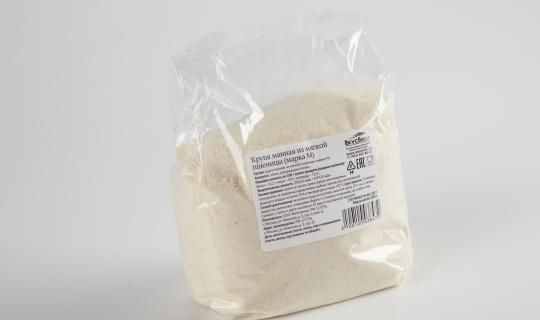
Rules for eating semolina porridge for a nursing mother
After weighing all the pros and cons, you can come to a general decision that semolina porridge does not provide any particular benefit. But, despite these disadvantages, you should not completely abandon this hearty and tasty porridge. To ensure that the presence of semolina in the diet does not harm either the baby or the nursing mother and that all the disadvantages of this cereal can be easily minimized, you need to follow simple recommendations for eating and preparing porridge:
- It is necessary to completely stop eating semolina in the first couple of months of the baby’s life, when his digestive system is still too sensitive and is just beginning to adapt to the new diet.
- If after 2-3 months the baby suffers from colic, then you should postpone eating semolina until he is 4-5 months old.
- Like any other product, mommy needs to introduce semolina porridge into her diet in the form of a small portion, and then observe the baby’s reaction throughout the day. If there are any signs of allergy, you should avoid this type of cereal.
- You need to cook semolina porridge in water and do not add too much sugar. If the child’s reaction is good, you can dilute the water in which the semolina porridge is cooked in half with milk.
- Try to give the semolina porridge the most liquid consistency. So there will be very little semolina in the finished dish, which means it won’t do much harm.
- Eat semolina porridge for breakfast no more than 1-2 times a week. This diet during breastfeeding will not harm either the baby or the nursing mother, because porridge is absorbed better on an empty stomach, which is why the unpleasant consequences of its consumption will be minimized.
Standards of use
Porridge, like any other new product, must be introduced into the diet of a nursing mother carefully. If you adhere to certain rules and norms of use, the risk of developing allergies in a woman and baby is minimal:
- It is better to eat semolina porridge in the morning, so there will be time to monitor the newborn’s reaction to the new treat.
- Introduce into the diet no earlier than the child is 3 months old.
- For the first dose, make semolina in water, liquid like soup. You are allowed to eat 1–2 tbsp. spoons. Afterwards, the baby’s health condition is monitored.
- If there are no allergic reactions, the porridge is cooked in water with the addition of milk (proportion 1:1) and only then switches to a completely milk version.
- The daily consumption rate is 100–150 grams. You are allowed to eat no more than 300 grams per week.
- At first, it is forbidden to use sweeteners, honey, sugar, fruits. This provokes the fermentation process in the stomach.
When adding dried fruits and other ingredients to the porridge, it is worth checking each product separately to see if the baby has an allergic reaction to it. If the mother notices side effects from eating semolina, then stop taking the product. You can try again after 30–60 days.
Low nutritional value does not allow you to eat semolina often. It is important to remember that allergies manifest themselves not only externally, but also internally. Possible fever, heart failure and difficulty breathing.
We suggest you read: What to eat for pregnant women to avoid gas formation
Let's sum it up
The solution to the question of whether semolina porridge is possible during breastfeeding should be left to the young mother. It is important to always remember that a happy and satisfied mother means a happy and satisfied baby. And if the mother is already tired of frequent waking up at night, household chores and caring for the child, then there is no reason to limit yourself to your favorite dishes, even if they do not contain a full range of nutrients.
Surely the taste of semolina porridge is familiar to everyone from childhood. This product is made from certain varieties of wheat, the grains of which are cut very finely. But when choosing, you should read the label. So, for example, the letter “M” will indicate that soft wheat was used in production. You can also distinguish by color; semolina in this category is white. Category “T” is made from hard varieties and has a yellowish tint. "M" is a mixture.
Overall, semolina porridge is a simple and satisfying dish that is very easy to prepare. For 1 liter of milk you need about 3-4 tablespoons of semolina, or 2 tablespoons if you don’t like thick porridge. Semolina contains many useful vitamins and minerals: most of all vitamin E (2.55 mg per 100 g), PP, B1, B6, B9, as well as iron (1 mg), zinc, copper, chromium, fluorine and silicon.
Why is semolina porridge harmful when breastfeeding?
The main danger of semolina porridge is its gluten content, a substance that not every body can tolerate. If you are allergic to gluten, you should avoid semolina porridge. What else is harmful about semolina porridge:
- Semolina contains phytin, which contains phosphorus, which binds calcium salts and prevents its absorption by the body. That is why it is recommended to eat semolina porridge with foods that contain calcium: dairy products, sesame seeds or almonds.
- 100 g of semolina contains approximately 360 kcal, so mothers who want to quickly get rid of extra pounds gained during pregnancy should not overload. Adding sugar and butter to porridge will only increase the calorie content of the dish.
- A large amount of semolina in the diet of a nursing mother can cause bloating in the baby, so you need to know when to stop.
How to eat semolina while breastfeeding?
- It is necessary for a new mother to introduce semolina into the menu when the child is at least 2 months old.
- You can cook semolina with milk and water. If you are trying it for the first time, it is better to choose the second option - on the water. Make a rare porridge and eat a small portion - up to 70 g. Look at the baby’s reaction. If allergies do not appear, you can gradually increase the portion and switch to cooking with milk.
- It is recommended to consume semolina porridge once a week when breastfeeding. Weekly portion - up to 350 g.
- Do not add sweeteners to semolina, as this will increase the calorie content of the dish. Also, you should not combine semolina with berries and fruits, as the latter can cause fermentation in the gastrointestinal tract.
Before introducing semolina into the diet of a nursing mother, you should consult your doctor!
Also pay attention to - an excellent breakfast after childbirth, because the body needs to regain strength and produce milk.
Why did semolina porridge once have the same meaning as oatmeal for the British, but today it is persona non grata for many? In light of recent events, is it possible for a nursing mother to have a plate of her favorite semolina? Let's try not to go to extremes and find a middle ground between the “bad” and “good” qualities of this controversial dish.
What is semolina made from?
Semolina is obtained at flour mills during the processing of wheat. If the package with semolina is marked “M”, then this indicates that soft varieties of wheat were used, respectively, “T” - hard, “MT” - a mixture of hard and soft. “Soft” semolina is white, and “hard” semolina has a yellowish tint.
We can say that semolina is wheat flour, but more coarsely ground with small particles of grain kernels with a diameter of 0.25 mm to 0.75 mm. Semolina made from soft wheat boils quickly and swells more, and it is this semolina that is most often used for preparing porridges. From durum semolina you can cook porridge similar to cereal - crumbly, with less volume but a richer taste.
The porridge swells due to the high content of gliadin, glutenin and starch proteins in the endosperm (kernel) of wheat, which absorb 200–300% of water relative to their weight. The chemical composition of the endosperm from which semolina is obtained is presented:
- starch (78–82%),
- protein (13–15%),
- sucrose (2%).
The same applies to vitamins, since the main part of them, along with micro and macroelements, leaves semolina with a grinding by-product - bran. The main vitamins of semolina are B1, B2, B6, H, PP.
The special status of oatmeal during breastfeeding
Preparation
To ensure that your baby’s intestinal function is not disrupted, you need to prepare manna correctly. Before mixing the components, semolina is soaked in water and saturated with moisture. It is not recommended to immediately add nuts, citrus fruits, dried apricots, and raisins. If manna is prepared with kefir, then the kefir should be fresh and low-fat. It’s better not to add honey, but to pour it over the finished pie.
- eggs – quail: 5 pieces, chicken – 3 pieces;
- kefir – 0.5 l.;
- semolina – 250 g;
- salt and sugar to taste.
The cereal is mixed with kefir to a homogeneous consistency without lumps, leave for 50 minutes in a closed container. At this time, the semolina swells. A separate container is needed for whipping sugar with eggs and salt to obtain a homogeneous mass.
Mannik on kefir with prunes and dried apricots without flour
- kefir – 0.5 l
- semolina – 250 g
- eggs – 3 pcs. (or 5 quail)
- sugar - to taste
- salt - a pinch
- prunes - to taste
- dried apricots - to taste
- juice of half a lemon
- butter - for greasing the pan
1. In a large bowl, mix semolina with kefir so that there are no lumps, cover with a lid and leave for 40 - 50 minutes so that the semolina swells. 2. In another bowl, beat the eggs with sugar and salt until smooth. 3. Add the egg mixture to the swollen semolina and mix thoroughly. 4. Wash the prunes and dried apricots, soak for 30 minutes, then cut into small pieces and also add to the dough. 5. Squeeze lemon juice into the dough and mix thoroughly so that the prunes and dried apricots are distributed evenly. 6. Grease a baking dish with butter, place the prepared dough in it and place in a preheated oven. Bake for 40-50 minutes. at a temperature of about 180°C. The readiness of the manna can be determined by using a match or a toothpick by piercing it in the center: if the match comes out dry, then the manna is ready. It should have a ruddy top, brownish in color.
Instead of dried apricots and prunes, you can put finely chopped apples
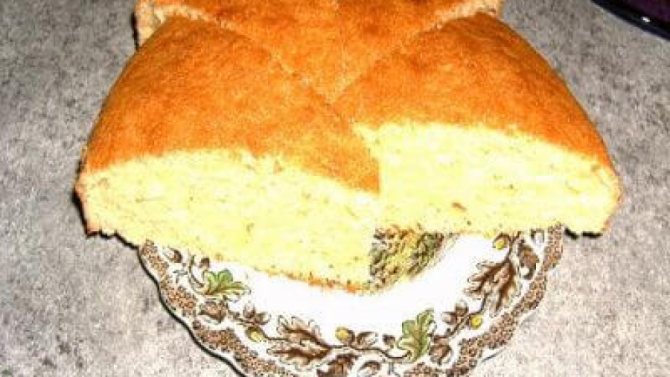
“Bad” and “good” semolina porridge: all the pros and cons
1. Nutritional value of semolina
From the point of view of a healthy diet, semolina porridge has no value. Substances that are most beneficial for digestion and human health are concentrated in the peripheral parts of the wheat grain, which are removed during the production of cereals. It contains very few vitamins and minerals.
But the same can be said about white bread, since their composition is identical, except for the yeast. Despite this, “bread is the head of everything,” and rarely does it occur to anyone to talk about its dangers.
Semolina porridge helps well with exhaustion and quickly saturates the body with “light” carbohydrates. The protein component of porridge, although not comparable to meat, eggs or fish, will satisfy part of the body's needs for 11 essential amino acids. If a nursing mother is very hungry, and there is a mouse hanging in the refrigerator, then semolina porridge can quickly satisfy the feeling of hunger and replenish the body with the necessary energy to support breastfeeding.
The calorie content of porridge (without sugar, butter, milk and other additives), contrary to popular belief, is not so high - 80 kcal per 100 grams. But by eating only one semolina, you can quickly stretch out your legs due to the imbalance of its composition and the lack of all the necessary components for proper breastfeeding and the health of the nursing mother.
2. Gluten: is it dangerous for a child?
Gluten is the main protein of semolina and a strong argument in favor of a nursing mother not consuming semolina porridge. Often, newborns and young children experience intolerance to this plant protein. It can be congenital, when a nursing mother or relatives of the baby have such a disorder, or temporary.
Congenital intolerance occurs when there is a hereditary deficiency of enzymes capable of digesting protein and is lifelong. This anomaly is called celiac disease.
Undigested gluten molecules damage the intestinal villi and reduce the number of beneficial microflora.
As a result, the digestion process worsens, and the body is poisoned by waste products of pathogenic microorganisms that beneficial bacteria cannot cope with.
Which nuts are best for breastfeeding and what are their dangers?
Temporary intolerance goes away as the child grows and the digestive system matures. Now pediatricians, in order not to provoke an allergy in a child, recommend starting complementary feeding with gluten-free porridges - buckwheat, corn or rice. When breastfeeding, gluten molecules that are not broken down by the mother's digestive system can be absorbed into the blood and then penetrate into breast milk. How can you tell if your breastfed baby is gluten intolerant?
Please note that after eating baked goods and semolina porridge, a child experiences diarrhea, increased gas production, skin rashes on the knees, buttocks, elbows and head, pale skin, and irritability.
To confirm your suspicions, you can donate blood from a vein to check for antibodies to cereal proteins. If a baby has a temporary gluten intolerance, then you should give up semolina porridge and try to introduce it into your diet gradually, no earlier than the child reaches 3-4 months of age.
3. Phytin and decreased calcium absorption
There are legends that semolina porridge reduces the absorption of calcium. Moreover, an innocent substance in wheat cereal - phytin - has undeservedly suffered from people's rumors. Firstly, phytin is concentrated in the wheat shell, which is eliminated when the grain is crushed and becomes a component of bran. Secondly, phytin is known in medicine as a substance that normalizes phosphorus-calcium metabolism and promotes bone formation. It is even added to the vitamin-mineral complex D-calcine to enhance the effect. In the intestines, it binds excess calcium if you have eaten too much phytin, as they say.
Another thing is starch, of which there is a lot in semolina porridge. It can impair the absorption of calcium. And it is also reduced:
- zinc and iron,
- competing with calcium for absorption,
- cellulose,
- sweets,
- coffee,
- fatty food,
- oxalic acid, found in beets, spinach, almonds and rhubarb,
- animal proteins,
- sedentary lifestyle,
- stress and age,
- urolithiasis disease,
- bleeding disorders,
- reduced immunity and so on.
What baking recipes are suitable for nursing mothers and is it possible to eat pies on the sly from a pediatrician
So the statement that semolina porridge is not allowed due to impaired absorption of calcium is far-fetched. When breastfeeding, nothing prevents you from separating the intake of calcium antagonist products with foods rich in this mineral.
If you look at it from this angle, then milk semolina porridge is a useless food for the purpose of obtaining calcium from milk.
So is it possible or not to have semolina porridge while breastfeeding? It is harmful only in one case - if your baby has gluten intolerance. In all other respects, semolina is an absolutely harmless product. Just do not forget that everything should be in moderation and with the help of only this dish you will not be able to provide adequate nutrition during breastfeeding.
Intake of dairy products while breastfeeding is very important. An additional source of calcium plays a key role during the growth period. Many people wonder how useful semolina porridge is during lactation. Of course, this dish can be included in the main diet of a nursing mother.
Semolina porridge contains a fairly large amount of vitamins (E, PP, B1, B2, B6, B9, E) and minerals (iron, copper, boron, vanadium, zinc, manganese, titanium and many others).
Since during lactation a nursing mother needs a varied diet with meals every three hours, this dish can easily be made one of those that can be consumed in a given period of time.
When breastfeeding, it is necessary to eat semolina porridge taking into account the following precautions:
- Cereals contain large quantities of gluten, which can cause an allergic reaction in the baby;
- Frequently consuming semolina can provoke an imbalance in the gastrointestinal tract;
- the high content of chitin in cereals interferes with the normal absorption of vitamin D, iron, and calcium by the body, which can subsequently lead to a deficiency of microelements;
- Since semolina is very high in calories, overeating it can lead to bloating and colic.
Recipe
Making semolina porridge is very simple. All you need is to have all the necessary ingredients and the desire to cook. So, you will need:
- 2 glasses of milk;
- 2 tablespoons of semolina;
- Salt, sugar to taste.
The milk should be brought to a boil and, with constant stirring, carefully introduce the semolina in a thin stream. During the entire cooking process, the porridge must be constantly stirred to prevent lumps from forming. A few minutes before turning off, add salt and sugar to taste. Turn off the gas and let the porridge stand for a while.
To at least somehow diversify the taste, sugar can be replaced with other products. For example, put a few slices of chocolate or a couple of spoons of jam into the finished dish. In addition, you can add a piece of banana or other fruit directly to the plate.
The easiest recipe for making semolina
Mix a glass of milk and a glass of water, pour into a saucepan and bring to a boil. Gradually add 2 cups of semolina in small portions, remember to constantly stir the contents of the pan to prevent the formation of lumps. Cook for 5-8 minutes over low heat, add salt and sweeten the dish to taste. Remove from heat, cover the pan with a lid and let it brew.
When serving, add your favorite berries or fruits, you can put a little oil, preferably vegetable, for example, peanut. Bon Appetit everyone!
Komarovsky's opinion
The well-known doctor Komarovsky notes in his works the benefits of consuming semolina porridge for both children and adults. According to him, semolina porridge is as beneficial for the body as many others. In addition, this type of product is one of the most affordable, which can be purchased by people of any income.
However, it is not recommended for a nursing mother to eat semolina porridge until the baby is at least 2 months old. At the same time, it is better to do the first preparation of porridge in water. Porridge should be introduced into the diet in small portions, observing the toddler’s reaction.
